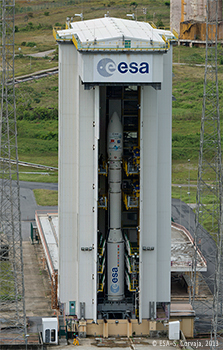
Following Friday’s scrubbed launch attempt, due to high winds at the Guiana Space Center in Kourou, French Guiana, Arianespace has successfully launched its second Vega lightweight booster to deploy three satellites into two different orbits. Liftoff of the ambitious VV-02 mission took place in rainy conditions at 11:06:31 p.m. Kourou time on Monday (2:06:31 a.m. UTC on Tuesday), and the 98-foot-tall, four-stage rocket quickly disappeared into a deck of low cloud cover. Within two hours, its primary task to deploy satellites for the European Space Agency (ESA), the Vietnamese government, and students from Estonia had been completed and Vega’s versatility as a small launcher was triumphantly demonstrated.
According to Arianespace—the French-led launch organization, headquartered near Paris—the countdown clock was halted at exactly T-30 minutes on Friday night and Vega was kept in a “ready-to-launch” configuration, with controllers able to resume the count at very short notice. This key benefit was enabled in part by the fact that the rocket’s three lower stages are all solid-fueled. Only the Attitude Vernier Upper Module (AVUM) utilizes a mix of two liquid propellants, unsymmetrical dimethyl hydrazine and nitrogen tetroxide.

Last night’s attempt proceeded smoothly, with Vega transferring to automated control at T-4 minutes and launching precisely on time, within a one-second “window.” The first seven minutes of the VV-02 flight—whose nomenclature honors Vega itself, the French word for “flight” (“vol”) and the numerical sequence of the mission—were powered by the three solid-propellant stages: the P-80 first stage, which burned for 109.8 seconds and produced 683,400 pounds of thrust, followed by the Zefiro-23 second stage, which fired for 77.7 seconds with 269,700 pounds, and finally the Zefiro-9 third stage, with a yield of 47,880 pounds and a duration of 117 seconds.
After the burnout of the Zefiro-9, the turn came of the AVUM, with its Russian-built RD-869 restartable engine, which was tasked with four discrete burns during VV-02. The first firing began at 11:13 p.m. Kourou time (2:13 a.m. UTC). After the completion of this five-minute burn, the AVUM and its three satellite passengers coasted for 41 minutes, ahead of the second burn. The first of these satellites—Proba-V, built by ESA—separated from the upper half of the Vega Secondary Payload Adaptor (VESPA) at 12:02 a.m. Kourou time (3:02 a.m. UTC). Weighing 308 pounds, Proba-V was by far the largest payload aboard VV-02 and was inserted into a Sun-synchronous orbit of about 510 miles.
Its role is to support new technology development for Earth-resources instrumentation. Specifically, it carries a reduced-mass version of the Vegetation instrument, currently used by the French Spot-4 and Spot-5 satellites, and will provide daily overviews of global vegetation growth patterns. Initiated by the Belgian Science Policy Office, the Proba-V spacecraft was built by ESA and its scientific focuses include land use, vegetation classification, crop monitoring, famine prediction, food security, disaster planning, and biosphere studies. Since the Spot-5 mission is due to end in mid-2014, Proba-V offers vital continuity, ahead of the first launch of the next-generation Sentinel Earth-observation program.
Nine minutes after the Proba-V separation burn, at 12:11 a.m. Kourou time (3:11 a.m. UTC), the AVUM fired a third time to reduce the vehicle’s perigee and inject Vietnam’s VNREDSat-1 and Estonia’s ESTCube-1 satellites into a lower orbit of about 420 miles. A fourth burn then circularized this “new” orbit, and at 1:02 a.m. Kourou time (4:05 a.m. UTC) the Vietnamese payload was deployed from the VESPA, to be followed three minutes later by ESTCube-1, which marked Estonia’s first home-grown artificial satellite.

Vietnam’s VNREDSat-1 weighs 165 pounds and is part of an effort to develop an orbiting infrastructure to study climate change, predict natural disasters, and optimize the management of natural resources. It was built by Astrium on behalf of the Vietnam Academy of Science and Technology. The final payload aboard VV-02 was Estonia’s 2.9-pound ESTCube-1, which has been assembled by students at the National University of Tartu, in conjunction with the Estonian Space Office, the Finnish Meteorological Institute, and the German Space Center (DLR). One of the primary functions of the tiny CubeSat will be the extension of an “ultra-thin and hopefully snap-proof” conducting tether to test electrical solar wind sail technologies. ESTCube-1 is expected to survive in orbit for about 12 months, whereas Proba-V and VNREDSat-1 may endure for up to five years.
Unlike the first flight of Vega back in February 2012, which was conducted under the auspices of ESA, this second mission saw Arianespace—the French-led launch organization, headquartered near Paris—assume primary operational responsibility of the vehicle for the first time. Vega represents the smallest member of Arianespace’s fleet, alongside the medium-capacity Soyuz and the heavy-lift Ariane 5.
Although last year’s VV-01 launch demonstrated the performance of Vega itself, this second flight was far more ambitious, not least because it placed its passengers into quite different orbits. It marked the first in a series of five Vega Research and Technology Accompaniment (VERTA) missions to demonstrate its flexibility and ability to transport multiple spacecraft into different orbits. In future developments, Arianespace hopes to utilize Vega in 2015 to launch the LISA Pathfinder—a technology demonstrator for the joint NASA/ESA Laser Interferometer Space Antenna—into a “halo orbit” around the L1 Earth-Sun Lagrange Point.
Although Vega includes co-operation between France, Belgium, The Netherlands, Spain, Switzerland, and Sweden, it is Italy which has driven the program with a 65-percent contribution. “Vega” is an Italian-language acronym for Vettore Europeo di Generazione Avanzata (Advanced Generation European Carrier Rocket). It has no strap-on rockets, but instead consists of three solid-fueled stages, all built by Avco, the Turin-based aerospace and defense contractor, together with the AVUM fourth stage. After separating its three satellite payloads, the AVUM’s fourth burn also served to de-orbit itself and thus eliminate the risk of creating additional space debris.
Want to keep up-to-date with all things space? Be sure to “Like” AmericaSpace on Facebook and follow us on Twitter:@AmericaSpace



